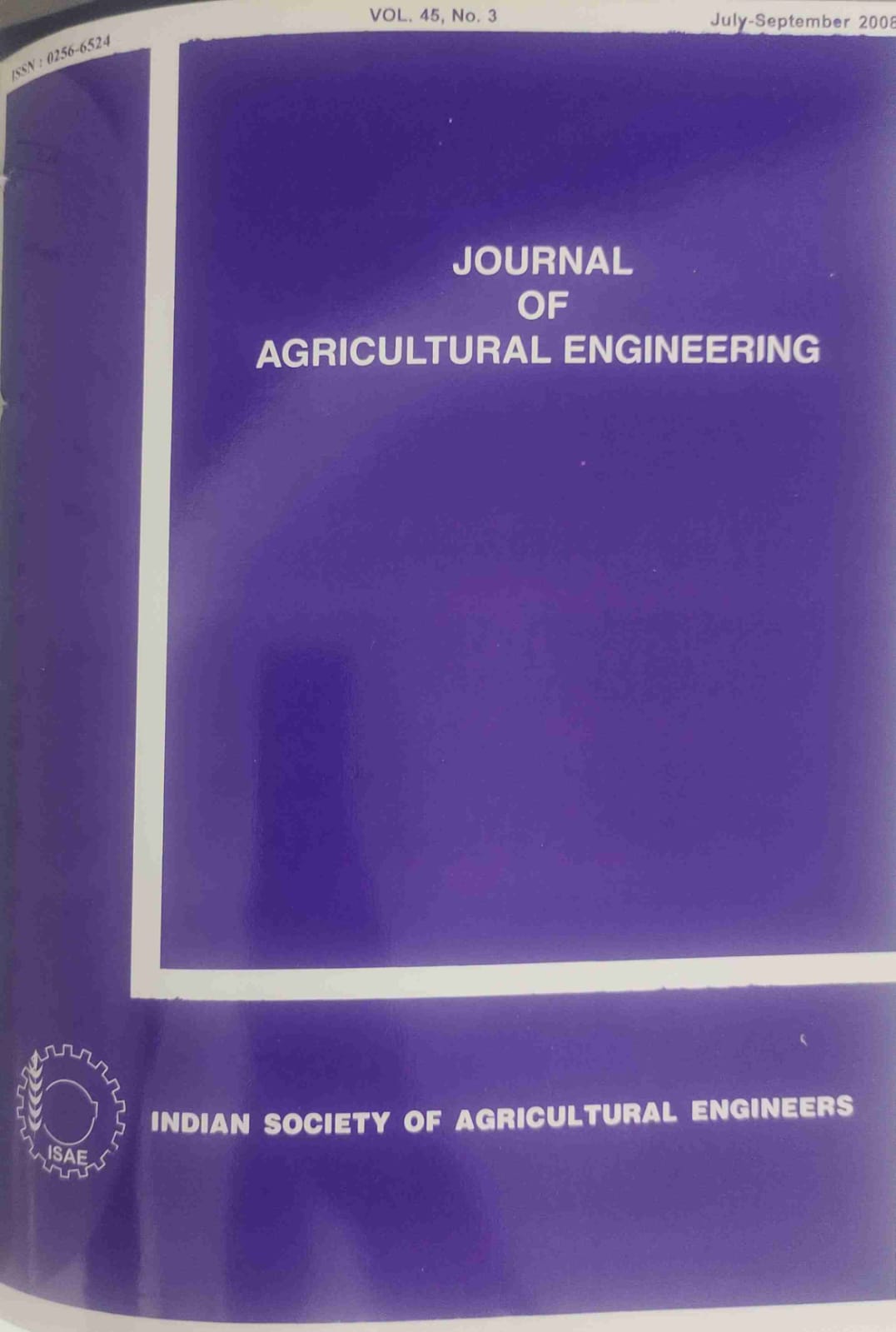Modelling ofMass Transfer in Osmotic Dehydration ofAonla Slices
DOI:
https://doi.org/10.52151/jae2008453.1338Abstract
The study on osmotic dehydration of aonla slices was carried out in order to remove the moisture prior to the further mechanical drying. Three sugar concentration levels (500B, 600B and 700Brix), three temperature levels of osmotic solution (300e, 45°e and 60°C) and constant solution to fruit ratio of 6: 1 (V/W) were selected and the observations on water loss and solute gain were taken at an interval of 15, 30, 60, 90, 120, 180 and 240 min. A two parameter mathematical model developed by Azuara et al. was used for describing the mass transfer in osmotic dehydration of aonla slices. The effect of time on mass transfer kinetics was investigated and the constants of two parameter model and final equilibrium points for moisture loss as well as solute gain were found. The water loss from and solute gain by the aonla samples increased non-linearly with the duration of osmosis at all sugar concentrations, and both were higher in the initial period of osmosis than the later period. Further, both increased with increasing sugar concentration. The model was able to predict osmosis mass transfer data up to the equilibrium point using data for relatively short period of osmosis.
References
Anonymous. 1989. Quality and Preservation of Vegetables. (ed. Eskin N AM). CRC press Inc; Florida, 75-119.
AOAC 2000. Official Methods of Analysis (984.25). 17th Edn. Association of Official Analytical Chemistry, Maryland, 14.
Azoubel P M; Murr F E X. 2004. Mass transfer kinetics of osmotic dehydration ofcherry tomato. J. Food Engng., 61,291-295.
Azuara E; Beristain C I; Garcia H S. 1992. Development of a mathematical model to predict kinetics of osmotic dehydration. J. Food Sci. Techno!., 29, 239242.
Beristain C I; Azuara E; Cortes R; Garcia H S. 1990. Mass transfer during osmotic osmotic dehydration of pineapple rings. International J. Food Sci. Techno!., 25, 63-66.
Biswal R N; Bozorgmehr K. 1992. Mass transfer in mixed solute osmotic dehydration of apple rings. Trans. , ASAE. 35, 257-262.
Chenlo F; Moreira R; Fernandez Herrero C; Vazquez G. 2006. Experimental results and modeling of the osmotic dehydration kinetics of chestnut with glucose solutions. J. Food Engng., 74, 324-334.
Ertekin F K; Cakaloz T. 1996. Osmotic dehydration of peas. 1. Influence of process variables on mass transfer. J. Food Processing and Preservation, 20,87-104.
Escriche I; Garcia P R; Andres A; Fito P. 2000. Osmotic dehydration of kiwi fruit (Actinidia chinesis): Fluxes and mass transfer kinetics. J. Food Process Engng., 23,191-205.
Ghosh P K; Agrawal Y C; Jayas D S; Kumbhar B K. 2004. Mass transfer kinetics model of osmotic dehydration of carrots. Trans. ASAE., 47, 1179-1185.
Hawkes J; Flink J M. 1978. Osmotic concentration of fruit slices prior to freeze dehydration. J. Food Processing and Preservation, 2, 265-284.
Islam M N; Flink J M. 1982. Dehydration of potato. II Osmotic concentration and its effect on drying behaviour. J. Food Tehno!., 17,387-392.
Khan M; Andres A; Shankar T J; Oliveira FAR; Cunha L M. 2005. Analysis of the effect of process variables on the osmotic dehydration of mango and process optimization using a genetic algorithm approach. Acta Hort., 674, 181-188.
Lazarides H N; Katsanidis E; Nickolaidis A. 1995. Mass transfer kinetics during osmotic pre-concentration aiming at minimal solid uptake. J. Food Engng., 25,151166.
Nanjundaswamy A M; Radhakrishnaiah S G; Balachandran C; Saroja S; Murthy Reddy K B S. 1.978. Studies on development of new categories of dehydrated products from indigenous fruits. Indian Food Packer, 22, 91-93.
Ozen B F; Dock L L; Ozdemir M; Floros J D. 2002. Processing factors affecting the osmotic dehydration of diced green peppers. International J. Food Sci. Techno!., 37,497-502.
Pokharkar S M. 2001. Kinetic model for osmotic dehydration of green peas prior to air drying. J. Food Sci. Techno!., 38, 557-560.
Pokharkar S M; Prasad S.1997. A model for osmotic concentration ofbanana slices. J. Food Sci. Techno!., 34, 230-232.
Pokharkar S M; Prasad S.1998. Mass transfer during osmotic dehydration of banana slices. J. Food Sci. Techno!., 35, 336-338.
Rastogi N K; Raghavarao I< S M S. 1997. Water and solute diffusion coefficients of carrot as a function of temperature and concentration during osmotic dehydration. J. Food Engng., 34, 429-440.
Shi J; Maguer M L. 2002. Osmotic dehydration of foods: Mass transfer and modeling aspects. Food Reviews International, 18,305-335.
Singh B; Kumar A; Gupta A K. 2007. Study of mass transfer kinetics and effective diffusivity during osmotic dehydration ofcarrot cubes. J. Food Engng.,79, 471-480.
Singh S; Shivhare U S; Ahmed J; Raghavan. 1999. Osmotic concentration kinetics and quality of carrot preserve. Food Res. Int., 32,509-514.














